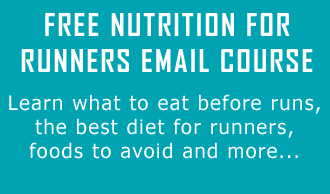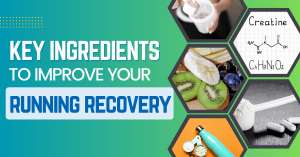What you eat after a hard workout affects your recovery and your ability to be ready for your next workout. Recovery (both physical and nutritional) is a critical part of an athlete’s training but nutritional needs for recovery vary depending on a number of factors:
- The length and intensity of the workout
- The workout conditions
- Your current nutritional status and physical fitness
- When your next workout is
In my blog last week I introduced the science behind energy metabolism and hopefully painted a picture of fuel use during different types of exercise. By knowing which energy system(s) we are using in our workouts, we can have a better idea of what our body may need for optimum recovery.

A typical training regimen for me consists of one tempo workout, one VO2 max workout, one long run, and four easy/recovery runs. This may vary depending on what training block I am in, but most of the workouts I do fall into one of these categories:
| Recovery/Easy | Long Run | Tempo Run | VO2 Max | |
| Pace | 1-2 minutes slower than my ½ marathon pace | Sometimes easy run pace, sometimes faster running included | Between marathon and 10k pace | Between 5k and 1 mile pace |
| % Max HR | 60-70% | 75-85% | 85-90% | 95-100% |
| Example | 4-10 miles | 10-20 miles | Continuous run or longer intervals (e.g. 1 mile repeats) | Speed work such as short intervals (e.g. 400m repeats) |
Not every athlete will have the same workout schedule or types of workouts, but thinking about the length and intensity of your workout will help you determine your nutritional needs.
Nutritional demands for different types of runs
Easy/recovery runs
These are exactly what the sound- easy efforts. During these runs you will be burning a combination of carbohydrate and fat, with a greater reliance a fat which is good for maintaining glycogen stores. Protein is usually spared from being used as an energy source as long as adequate carbohydrates and fats are available. However, if daily carbohydrate or energy intake is low or you exercise for longer than 60 minutes without eating before or during the exercise, protein may be used to meet energy demands. We want to prevent this as much as possible.
There are no major nutritional needs to worry about after an easy run. Just be sure to practice a normal day of healthy eating (which should be a daily habit), keeping in mind that any bit of exercise does increase your overall nutritional needs for that day. To help you determine exactly how much, you can use our running calorie calculator, which we share below.
Long runs
While long runs may sometimes be run at an easy pace, they are longer efforts. Longer efforts burn more calories and thus require more fuel. If you exercise in a fasted or under-fueled state and do not take in any calories while running, your body will want to get those calories back pretty quickly. It is a good idea to consume a high-carbohydrate meal as soon as tolerable to jump-start the refueling process. Quality protein sources are also important to replace any that was used to meet energy demands.
As with easy/ recovery runs, a normal day of healthy eating should replace these calories and nutrients lost as long as you keep in mind that you will need more calories than you would on a usual day.
I like to think of long run days as my “cheat” day where I can be a little more relaxed about what I eat and drink. However, be sure to spend a little bit of time focusing specifically on good recovery foods before getting too crazy. Always be thinking about the next week’s workouts and what you need to do to be ready. You can learn about good post-workout recovery foods in this previous article on post workout recovery fuel.
Tempo runs
Threshold efforts fall into that zone of training runs that flirt with the borders of aerobic and anaerobic metabolism. During tempo runs the goal is to stay at or just below your lactate threshold to prevent the accumulation of blood lactate yet still train at a high level. Interval training allows you to slightly exceed your lactate threshold, and then recover back to below threshold before the next bout.
Intensity is higher in this type of training so metabolism shifts to using more carbohydrate (blood glucose and muscle glycogen). It is very important to start these types of workouts with full stores of muscle glycogen since these stores will likely be depleted by the end of the workout.
Your first priority after the workout should be to replenish your glycogen stores by ingesting carbohydrate as soon as possible. For a more complete understanding of how the glycogen replenishment process works, check out this article on the two windows of recovery that exist after a hard workouts and good foods to ingest to promote optimal recovery
VO2 Max
These workouts are about as intense as it gets for distance runners. While these efforts are usually short, they require a lot of power output. These efforts will call on the anaerobic system almost exclusively. This means your body will only be using glucose for energy and your stores may become depleted quickly. Activity this intense can only be supported for 1-3 minutes at a time before a recovery interval is needed.
Nutritional needs after these types of workouts mimic those after a tempo workout, however the duration of the workout is probably shorter and you will have covered less total miles. Although caloric needs may not be quite as high, it is important to focus on high quality carbohydrates and protein to replenish glycogen stores and start the process of muscle repair.
RunnersConnect Bonus
Download your FREE Guide where we share the Best Foods to Eat Before Running.
The guide contains 5 of the most nutritious foods to eat before a run lasting 60 minutes or less and 10 foods that will fuel you through your runs over 60 minutes. Each of these carefully selected pre run foods will help you feel better in your training (while making sure they do not upset your stomach!)….we all know how bad that feels!
Final Notes
- Nutrition plays a very important role in the recovery, but so does rest. Your body needs more than just the right nutrients to help it recover from a hard effort. Adequate rest enhances the recovery process and also helps reduce the risk of injury and chronic fatigue. Furthermore, the body needs 1-2 days of physical rest and adequate carbohydrate intake to fully replace depleted glycogen stores.
- Fluid replacement should be a top priority, especially when conditions are hot or you are a heavy sweater. Fluids and electrolytes, which play key roles in exercise and metabolism, are lost through sweat. It is important to replace what was lost as soon as possible. A good practice is to weigh yourself before and after a workout. For every pound lost, you should consume 16oz (2 cups) of water or sports drink. To help you find your specific sweat loss, check out or sweat loss calculator.
- Recovery nutrition is most important for competitive athletes training twice a day or on consecutive days. If you are a recreational athlete or you have multiple rest days in between hard workouts, you do not need to stress as much about immediate nutritional recovery. Just be sure to maintain a daily diet that is well-rounded and adequate in carbohydrates.
- Remember that quality training is more important than quantity training. If you try to force workouts in when you are not fully recovered, you will not get the training effect you are looking for and may set yourself up for injury. Remember how the workout and recovery process works.








